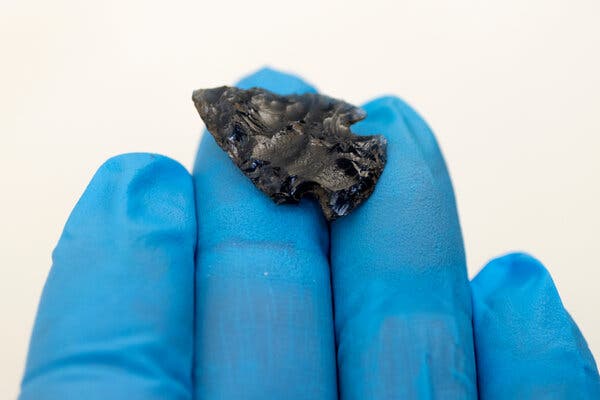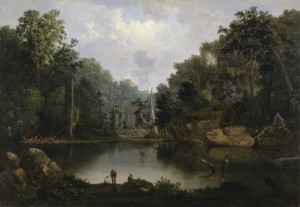Above: This arrowhead from Obsidian Cliff glass is about 1,500 years old. Credit…Natalie Behring for The New York Times
Obsidian is among the most prized tool stones in the world, and this particular deposit, nearly 100 feet thick, is exceptional because of its continuous use by Indigenous people since the last ice age. Over the last 11,500 years or so, the stone has been fashioned into deadly knives, razor-sharp spear points, darts for atlatls, or spear-throwers, and arrowheads.
One lingering mystery of Obsidian Cliff stumps scientists to this day: How, some 2,000 years ago, did hundreds of pounds of obsidian wind up at what is now Hopewell Culture National Historical Park in Ohio, about 1,700 miles east of Yellowstone. Researchers do not know if the material traveled through trading networks or was gathered by people who went on a special journey to the cliff. That’s one of the major shortcomings of the X-ray analysis.
“If someone sends me an artifact, I can determine the origin of it with a good degree of confidence,” Dr. Shackley said. “But determining how it got there is the kicker.”
In the early 1890s, excavators digging in Mound 25 at the Hopewell location near Chillicothe, Ohio, found an altar with more than 100 burned and broken obsidian spear points, also known as bifaces. One point was more than 17 inches long and 6 inches wide and believed to have been designed for ceremonial purposes. About three-fourths the obsidian at Hopewell has been traced back to Obsidian Cliff using the X-ray tech.
“The largest of these bifaces are master works, really remarkable,” said Timothy D. Everhart, a museum curator and archaeologist at the Hopewell park.
The allure of Obsidian Cliff’s stone glass can be seen as well as felt in its efficient use as a sharp weapon. In a recent paper, researchers outlined its noteworthy elements — abundance, access, aesthetics and quality.
Source: Yellowstone’s Obsidian Cliff: Humanity’s Tool Shed for the Last 11,500 Years – The New York Times



![Sandhill cranes land on Platte River sandbar roosts west of Rowe Sanctuary’s Iain Nicolson Audubon Center southwest of Gibbon, Nebraska. [Photo by Lori Porter| Kearney Hub]](https://www.ghostturtles.com/wp-content/uploads/2015/03/sandhill_cranes_kearneyhub_032015-300x225.jpg)
![An endangered Whooping crane takes flight. Yhe large bird has a 7-foot wingspan. It is all white except for black wing tips and face markings. In this photo its long neck stretches forward; its wings sweep upward; and its black legs trail straight behind it. [Source: International Crane Foundation]](https://www.ghostturtles.com/wp-content/uploads/2023/03/Whooping-crane-eastern-ICF-080622-300x157.jpg)

![Mark Willis peruses a 1745 volume by Voltaire at a bouquiniste book stall on the banks of the Seine in Paris. He wears a brown leather jacket and checkered flat cap. He holds the open book in his hands. Rows of old books are seen on shelves behind him. [2005 photo by Ms. Modigliani]](https://www.ghostturtles.com/wp-content/uploads/2023/03/mw_bouquiniste_05-300x225.jpg)


